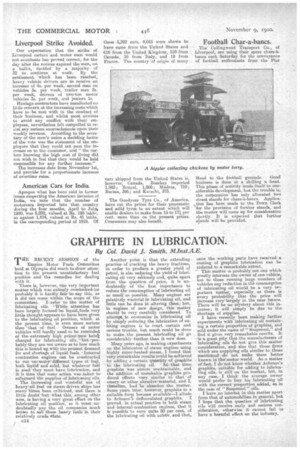GRAPHITE IN LUBRICATION.
Page 38

If you've noticed an error in this article please click here to report it so we can fix it.
By Col. David J. Smith, M.Inst.A.E.
T14E RECENT SESSION of the Empire Motor Fuels Committee held at Olympia did much to draw attention to the present unsatisfactory fuel position and the remedies for dealing with it There is, however, one very important matter which was entirely overloOked (or probably it is hardly fair to say this as it did not come within the scope of the committee). I refer to the matter of tubrieatiug oils. ' While attention has been largely focused-en liquid.fueds very little thought 'appears to have been given to the lubricating oil position, which at the present time, is even more serious than that of fuel. Owners of motor vehicles will hardly need to be reminded. of the extremely high pricee-now beint charged for lubricating oils,but probably they are not aware as to how much this isbound up with the present demand for and shortage of liquid fuels. Internal combustion engines can •be constructed. to um tnitmanye different types of fuel, both liquid and solid, but whatever fuel is used they must have lubrication, and it is time that some action was taken to safeguard the supplies of lubricating oils. The increasing and wasteful use of heavy' oil inel on steam-driveirships has many times been criticised, and there is little doubtsbut What this, among other uses, is having a very great effect on the lubricating oil position, as it must, imdoubtedlv pay the oil companies much better to sell these heady fuels in their relatively crude state.
c14 Another point is that the extending. practice of cracking the heavy fractions, in order to produce a greater yield of petrol, is also reducing the yield of lubricating oil very seriously and, quite apart from the question of price, it is undoubtedly of the first importance to reduce the consumption of lubricating oil as much as possible. Many engines are relatively wasteful in lubricating oil, and little can be done in altering them, but, in engines of DAM design, this matter should be very carefully considered. To attempt te economize in lubricating oil by simply reducing the lubrication of existing engines is to court certain and serious trouble, but much could he done to make the present lubricating oil go considerably further than it now does.
Many years ago, in making experiments on the lubricaton of steam engines using highly super-heated steam, I found that very remarkable results' eould be achieved by adding a certain: quantity of graphite
to the lubricating oil. At that time graphite was almost unobtainable, and the addition of unsuitable graphite produced effects very similar to that of emery or other abra.sive -material, and I, the'lefore, haeto abandon the matter. Some years later, however, graphite in a suitable form became available—I allude to Acheson' s deflocculated graphite. I proved, in actual practice in both steam and internal-combustion engines, that it is possible to save quite 50 per cent, of the lubricating oil with safety, and that,
once the working parts have received a. coating of graphite lubrication can be reduced to a remarkable extent.
— This matter is probably not one which greatly interests the owner of one vehicle, but to those running large numbers of vehicles any reduction in the consumption of lubricating oil would be a very portent matter, especially., as there is every probability that the price will increase very largely in the near future. There will be noniystery about this increase; it will simply be due to the shortage of supplies. I have recently been making further experiments with lubricating oil containing a certain proportion of graphite, and sold under the name of " Suspensol," and find it gives very remarkable results. It is a great pity that, the manufacturers of lubricating oils ao not give this matter consideration, and also that those firms which' are supplying oils similar to those mentioned slo not make them better known in thernoter world. As a matter of fact, I do not know whether Acheson's graphite, suitable for adding to lubricating oils, is still on the market, but, in any case, I think the average owner would prefer to buy his lubricating oil with the correct proportion added, as in the ease of " Suspensol " oils. I have no interest in this matter apart from that of autornobilism in general, but I hope that the question of lubricating oils will receive early and serious consideration, otherwise it cannot fail to have a harmful effect on the industry.


























































